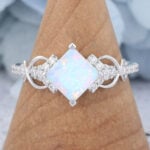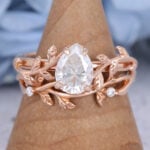How to Measure Ring Size: Easy Methods That Really Work
Knowing how to measure ring size is essential when buying a ring for yourself or as a gift. A well-fitted ring not only feels comfortable but also ensures it stays secure on the finger without slipping off or feeling too tight. Many people are unsure where to start, but with a few simple methods, you can find the right size at home without special tools. This ring measuring guide will walk through practical techniques to help you measure accurately and choose the perfect fit.
Why Knowing Your Ring Size Matters
Finding your ring size isn’t just about comfort; it’s also crucial for ensuring a secure and aesthetically pleasing ring. A ring that’s too large can easily slip and get lost, while a ring that’s too small can impair blood circulation and even make it difficult to wear. For special jewelry like engagement rings or wedding rings, accurate sizing can also avoid the hassle and expense of frequent re-sizing. Furthermore, the correct size ensures the ring’s design blends seamlessly with your finger, enhancing the overall wearing experience and visual appeal.
Common Ring Size Systems
Different countries and regions use different ring measurement systems. The most common ring sizing systems include those in the United States (US), the United Kingdom (UK), Europe (EU), and Japan (JP).
In the US and Canada, ring sizes are primarily numerical, typically ranging from 3 to 13, with slight variations between half sizes. In contrast, the UK and Australia use an alphabetical system, from A to Z, with each letter corresponding to a different circumference or diameter. European ring sizes are measured in millimeters, directly reflecting the inner circumference of the ring; for example, a size 52 indicates an inner ring of 52 mm. Japan and some Asian countries use a numerical system, but unlike the US, this system typically starts at 1, with larger numbers indicating larger sizes.
How to Measure Ring Size at Home
1. Check Ring Size with a String or Floss
Using a string or floss is one of the simplest and most practical at-home ways to figure out ring size. To measure, wrap the string or floss around the base of the finger where the ring will be worn. Make sure it is not too tight, as this may result in a smaller size, and not too loose, to avoid the ring being oversized. Mark the point where the ends overlap with a pen, then lay the string flat and measure the length in millimeters with a ruler. The ring size from circumference can then be matched to a standard ring size chart.
2. Using a Paper Strip
If you don’t have a string or floss, using a paper strip to determine your ring size is another easy way to figure out ring size. Start by wrapping the paper strip around the base of your finger, keeping it gently snug without being too tight. Mark the point where the ends overlap with a pen, then lay the strip flat and measure the length in millimeters with a ruler. The resulting circumference can then be matched to a standard ring size chart to find the correct ring size.
3. Measuring an Existing Ring
This method is suitable for those who already own a ring but don’t know its size and want to buy a new one. First, remove a comfortable-fitting ring you already have and measure its inner diameter—the widest part of the ring’s interior. You can use a ruler or caliper to measure the diameter in millimeters. Once measured, compare the diameter to a ring size chart to determine the corresponding ring size.
Note: Make sure the ring is laid flat and measured at the correct position, otherwise the size may be inaccurate.
4. Printable Ring Sizer
Using a printable ring sizer is another convenient way to know the size of a ring, especially for those who don’t have measuring tools at hand. First, download and print a ring sizer from a reliable website, making sure the print scale is correct and the page is not resized, to ensure accurate measurements.
To use it, either cut out the paper sizer or use the printed circles directly. Place an existing ring over the circles or slide your finger into the marked rings to find the best fit. Once you have the correct circle, you can match it to a standard ring size chart to determine the accurate ring size.
5. Buying an Affordable Ring Sizer Tool
Purchasing an affordable ring sizer tool is the most accurate and best way to find out your ring size. Common types on the market include plastic ring gauges, metal ring sizers, and adjustable measuring bands, all of which are inexpensive, easy to use, and capable of measuring finger size precisely.
Using the tool is straightforward: simply slide it onto your finger and adjust until it fits comfortably, then read the ring size directly. Compared to paper strips or string, a ring sizer tool reduces human error and is especially useful for those who frequently buy rings or need to measure sizes for multiple family members.
6. Using a Tape Measure
Using a tape measure to work out the ring size is a simple and straightforward method, ideal for quickly measuring with a common household tool. Wrap the flexible tape measure around the base of your finger, keeping it gently snug without being too tight. Record the length where the tape meets, which gives the circumference of your finger (usually in millimeters).
To ensure accuracy, it’s recommended to measure several times and take the average, and it’s best to measure when your fingers are at normal temperature and slightly relaxed.
Also Read: How to Measure Ring Size with Tape Measure
Men’s Ring Size Chart
When choosing a ring for men, finding the right fit is just as important as selecting the style. The average ring size for men typically falls between size 9 and size 11 in the US system, with size 10 being the most common. However, finger sizes can vary widely depending on body type, lifestyle, and even temperature. To help you determine the perfect fit, we’ve included a comprehensive Men’s Ring Size Chart below, which compares US, UK, Japanese, and Swiss sizing systems based on both inside diameter and circumference measurements.

Ladies’ Ring Size Chart
When it comes to women’s rings, knowing the right size is just as important as design and style. The average ring size for women is usually around size 6, though variations are common depending on finger shape and hand size. The typical women’s ring size falls between sizes 5 and 7, with size 6 often considered the most common women’s ring size. For a better reference, the Ring Size Chart for Women below includes both US sizes and a ring size chart in mm, making it easier for any female to match her measurement accurately and comfortably.

When to Seek Professional Help
While guides on how to measure your ring size at home can be helpful, they are not always precise. Small differences can make a ring too tight or too loose, especially when you try to estimate ring size without proper tools. If accuracy is essential, such as when purchasing an engagement or wedding ring, visiting a jeweler ensures a professional measurement. Expert assistance reduces errors and guarantees a comfortable, lasting fit.
Important Tips for Accuracy
- Measure your ring size at the end of the day when fingers are slightly larger.
- Avoid measuring when your hands are too cold or too warm.
- Take multiple measurements to ensure consistency.
- Consider the width of the ring, as wider bands fit more snugly.
- Use a proper ring sizer instead of paper or string for best results.
Conclusion
Finding the perfect fit is essential for both comfort and style, and understanding how to measure ring size helps you avoid resizing issues later. By following simple steps and paying attention to details, you can ensure your ring sits perfectly on your finger, making it both practical and meaningful.
FAQs About How to Measure Ring Size
Wrap a measuring tape around your finger, note the circumference, and compare it to a ring size chart.
Ring size is measured based on the inner circumference or diameter of the ring.
You can use printable ring sizers, online tools, or size charts provided by jewelry websites.
Finger circumference is the distance around your finger, usually measured in millimeters.
Measure the inside diameter of a ring that fits well and match it with a sizing chart.
Ring sizes are commonly measured in millimeters for diameter or circumference, depending on the system.
Use a ruler or caliper to measure the inside diameter of a ring in millimeters, then compare with a chart.
Measure your finger’s circumference in inches and convert it using a ring size chart.
Use a ring sizer, measuring tape, or compare with an existing ring to determine the size accurately.
The measurement method is the same, but men generally have larger sizes than women.
The average female ring size is typically between size 6 and size 7 in the US.
 Christmas: 25% off All ltems · Code AFJ25 ·Ends Dec 30 30% off All Items ·On Orders Over $600 – Code AMANDA30
Christmas: 25% off All ltems · Code AFJ25 ·Ends Dec 30 30% off All Items ·On Orders Over $600 – Code AMANDA30


